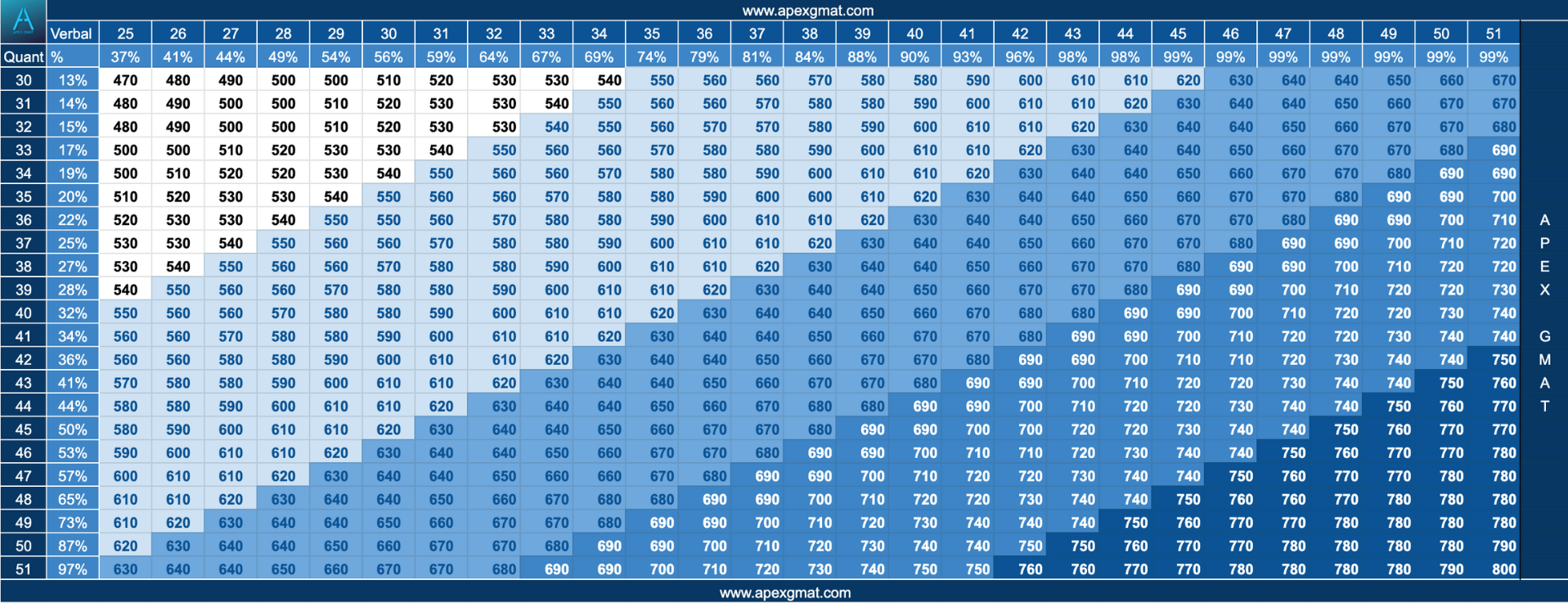The GMAT exam is an important part of the admissions process for over 7,000 business programs worldwide. GMAT performance is widely regarded as one of the best predictors of not only high academic honors, but also long-term career success. Achieving an excellent GMAT score and ranking in the top percentile is the first stepping stone in anyone’s journey to a prestigious business career. The competitive admissions environment surrounding top tier universities has resulted in a 10-20% acceptance rate. This corresponds with percentile rankings in specific sections: for example, the GMAT Quant. But what do percentile rankings really mean? This article describes the relationship between GMAT scores and respective percentile ranking, both in terms of individual sections and as a whole.
How do GMAT scores translate into GMAT percentiles?
According to the GMAC, two-thirds of test takers from all over the world score between 400 and 600. GMAT scores also translate into a percentile ranking. A number indicating the percentage of test takers at or below a given score. Percentile rankings are determined by comparing scaled Quant and Verbal scores (which can range from 6 to 51) to your peers’ scores. For instance, if you scored in the 90th percentile, that means that just 10% of all examinees outscored you. It’s important to note that the percentiles are recalculated every summer. This means that the current percentile rankings are likely different from the previous year’s rankings. The GMAC considers a sample size of test takers tracked since January 2019 to calculate percentiles. Until December 2021, a total of 414,618 GMAT exams were taken and scored, with a standard deviation of slightly above 9. Consequently, the GMAC shares average percentiles rankings for each of the four sections:
- Quantitative Reasoning: 22%
- Verbal Reasoning: 41%
- Integrated Reasoning: 31%
- Analytical Writing Assessment: 19%
While these numbers seem low, applicants need to score well above the average to earn a spot in the most competitive business schools.
GMAT Score Chart

How have percentile rankings changed by section?
Over the years, there is a trend towards increasing average GMAT scores and, consequently, percentiles have risen, too. In particular, the GMAT Quantitative percentiles have become considerably more competitive and increasingly important for MBA admissions. As more and more test takers master the GMAT quant section, it gets harder to score in a high percentile. One reason may be that as the GMAT’s worldwide popularity increases, non-native English speakers coming from math-proficient countries such as China and India make up a large proportion of the GMAT test takers. On the other hand, the GMAT Verbal section remains rather challenging–a score of 40 out of 60 ranks in the 90th percentile. The increasing representation of non-native English speakers might also help explain why the verbal section remains challenging. In any case, a balanced GMAT percentile refers to the combined result of your scores on the Verbal and Quant sections.
What about the AWA and IR?
The Analytical Writing Assessment and Integrated Reasoning sections are scored separately. They also have their own scoring scale, independent from the 200 to 800 scale used to evaluate Quant and Verbal. A strong performance on the Analytical Writing Assessment and Integrated Reasoning sections can boost your admissions chances. Nevertheless, we recommend that applicants prioritize ranking in the top percentiles in the Quant and Verbal sections.
What do GMAT Percentiles mean for admissions to B-schools?
While most business schools don’t have a straightforward cutoff for GMAT results, the majority of admissions committees consider both percentile rankings and total scores. Top-tier institutions like Wharton, Stanford, INSEAD, and MIT are known to perform more in-depth analyses of candidates’ total scores compared with percentile rankings. These programs value exceptional scores, but place additional weight on how competitive candidates are compared with their peers. During particularly competitive admissions cycles, the most selective business schools only consider candidates who scored above the 90th percentile. Admissions decisions entail a more holistic selection process in which committees consider work experience, former education, motivation letters, resumes, recommendations, and other factors that signal applicants’ potential for success in the business world. If you want to get into the right business program, it’s a smart move to familiarize yourself with the yearly data reports that most business schools produce regarding their current students’ GMAT percentiles and scores.
Boosting your GMAT score
Depending on your score goals, current level of preparation, and anticipated exam date, you can opt for one of three GMAT prep options that will best suit your needs, budget, and learning style. If you’re aiming for a 700+ score, a professional GMAT tutor might provide the guidance you need to leverage your strengths and weaknesses. This could ultimately put you on the path to degree and career success.
